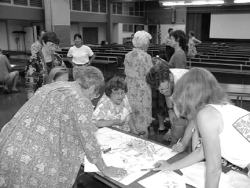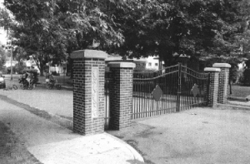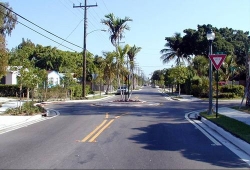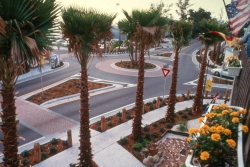Traffic Calming and Crime Prevention
Dayton, Ohio; West Palm Beach, Florida; Norfolk, Virginia; Fort Pierce, Florida
Source: Pedestrian and Bicycle Information Center (PBIC)
Problem
During the past 60 years many communities in the U.S. have been designed to accommodate automobiles, often to the detriment of cyclists, pedestrians, and residents.
Background
Traffic calming programs can help make bicycling and walking more comfortable and neighborhoods more livable and pleasant. Treatments such as curb extensions, medians, lane narrowings, and roundabouts are designed to slow vehicles on streets where speeds are too high. According to traffic calming expert Dan Burden (2000), "It is a way to reduce the negative effects of automobile use, alter driver behavior and improve conditions for the property owner, retailer, walker and bicyclist" (p. 11).
Although few studies of the relationship between traffic calming and crime prevention exist, there's growing evidence that residents in neighborhoods with slower streets are more likely to take ownership of those streets and in so doing increase the surveillance that is key to deterring crime. The concept of "eyes on the street" or "eyes on the public space," emphasized decades ago by urbanist and author Jane Jacobs (1961), clearly applies to traffic calming. Criminals will find a fast, unpleasant street lined with garage doors an easier target than a slow, quiet street watched over by motorists and people in homes with windows, porches, or front stoops. Motorists traveling at slower speeds are more aware of their surroundings and help deter crime, points out Police Officer Todd George of Overland Park, KS in Neotraditional Design and its Relationship to Preventing Crime.
The volume of traffic on a street influences the quality of neighborhood life. In 1969 in San Francisco, the Urban Design Group surveyed streets, conducted an attitudinal survey of residents, and completed a housing survey. During the two-year project, UC Berkeley Professor Donald Appleyard established a clear correlation between traffic volumes and neighborhood residents interacting with their neighbors. Appleyard (1981) compared heavy, medium, and light traffic streets; he found that on the street with heavy traffic people had withdrawn from the street altogether, leaving it to traffic. However, on the street with light traffic residents were more engaged in the street; children played outdoors more, and there was more ownership and awareness. According to Appleyard, "The contrast between the two streets was striking. On the one hand alienation, on the other friendliness and involvement" (p. 26).

A collaborative planning process has many benefits: it creates relationships and buy-in, fosters a sense of community, and itself may help to reduce crime. photo: Dan Burden
Traffic calming projects can increase a sense of community by slowing, redistributing and reducing traffic, by bringing people together to design the traffic measures, and by giving residents and retailers greater ownership of the public realm. Typically neighbors and city staff collaborate to develop traffic calming programs. Interestingly, the process of working together on a plan can help reduce crime. A study by Harvard University Public Health Professor Felton Earls found that "violent crime rates in communities in which residents willingly worked together were as much as 40 percent lower than in neighborhoods where such relationships were not as strong" (Local Government Commission, 1998, p.1).

This entry portal to a Dayton neighborhood restricts vehicle access but is open to pedestrians and bicyclists. photo: Local Government Commission
Solutions
Dayton, OH lowers crime through street closures
While most traffic calming measures aim to slow traffic and divert some cars and trucks to more appropriate streets, the city of Dayton took a more radical step to deal with crime in the Five Oaks neighborhood. In the early 1990s heavy traffic and cruising for drugs and prostitution drove residents into their homes and made the streets a no-man's land. The city helped neighbors reclaim the streets by closing them to through traffic. The neighborhood was divided into ten mini-neighborhoods of three to six streets; one opening to the adjacent arterial was converted to an entry portal identified by attractive brick pillars. Other streets into the smaller neighborhoods were blocked off by iron gates which could be unlocked to provide access to emergency and maintenance vehicles.
Although motor vehicle access was limited, pedestrians and bicyclists could still move into and through the neighborhood (Cisneros, 1995). Traffic calming, along with a plan to promote homeownership, resulted in a 25-50 percent reduction in neighborhood crime and encouraged more resident and community involvement. Traffic passing through the neighborhood declined by two thirds and the number of crashes dropped by 40 percent (Burrington and Heart, 1998).

A traffic-calming roundabout and fresh streetscaping transformed this West Palm Beach neighborhood as well as the street. photo: Dan Burden
Traffic calming revitalizes neighborhoods in West Palm Beach, FL
The neighborhoods of Old Northwood and Northboro Park in West Palm Beach were havens for drug dealers and prostitutes in the 1980s. In an effort to stop commuters from cutting through these neighborhoods, the city implemented traffic calming measures which incidentally reduced the crimes that poor street environments had fostered. The number of arrests for prostitution dropped from 100 in 1992 to less than 20 in 1997, an 80 percent decrease. Over the same period, incidents involving drugs and narcotics fell from approximately 38 to less than 15, a 60 percent decrease. Street crime decreased because traffic calming changed Old Northwood and Northboro Park residents' relationship to their streets (Stillings and Lockwood, 2001).
Traditional neighborhood design project, Diggs Town, Norfolk, VA
Diggs Town is a low-rise public housing project; most residents are single African-American women and their children. Unemployment, crime, drugs, and decay plagued Diggs Town; according to a Fannie Mae Foundation report, "The residents feared for their lives and felt they had lost control of their community" (Bothwell, Gindroz, and Lang, 1998, p. 95). The street pattern in the neighborhood didn't allow access to the inner parts of the complex or easy supervision by residents. This isolated the central part of the project; it became a hub of criminal activity. In 1990 the Norfolk Redevelopment and Housing Authority awarded Urban Design Associates $17 million to redevelop Diggs Town. Parking islands and tree-lined, small-scale streets provided better access and improved the community. Adding front porches and fences encouraged feelings of ownership; articulating entrances and re-landscaping public spaces created coherence and identity.
According to a community police officer, police calls dropped from 25-30 per day to 2-3 per week. When asked what had made the difference, he cited a renewed sense of pride and self-esteem, which led residents to identify and engage with the community. Interviews with residents suggested that the physical form and image of Diggs Town had some effect on the stability of the neighborhood (Bothwell, et al).

An appealing, pedestrian-friendly roadway changed residents’ perceptions of Fort Pierce’s waterfront and historic downtown. photo: Dan Burden
Roundabout and traffic calming restore historic waterfront in Fort Pierce, FL
Traffic and poor design in the historic downtown and waterfront areas of Fort Pierce produced an unappealing pedestrian environment and declining street life. In 1995 the City of Fort Pierce, the Main Street Fort Pierce program, and the Treasure Coast Regional Planning Council jointly sponsored a community charrette to address these issues. The resulting plan included a roundabout at the gateway between the historic downtown and waterfront areas which serves as both a traffic-calming device and a civic monument. A connected system of new waterfront streets extends from the roundabout. Curb extensions, median refuge islands, and clearly marked crosswalks make pedestrian crossing safer and easier. This infrastructure helped prompt a return of pedestrian activity. Ramon Trias, a professional town planner and urban designer, lives in the historic neighborhood between two roundabouts and can speak about their effect on the area from 12 years' personal experience: "Before the roundabouts, the neighborhood was infested with crime and was not even seen as historic. Now it has become one of the best places to live in Fort Pierce, and it is praised for its historic houses and safe streets" (R. Trias to P. Zykofsky, personal communication, July 19, 2007).
Web sites
Follow this link to learn about pedestrian and bicycle planning and design issues that should be considered when reengineering streets for traffic calming projects:
http://www.pedbikeinfo.org/training/gettraining.cfm
Contact
Kate Wright, Project Specialist
Local Government Commission
1414 K Street, Suite 600
Sacramento, CA 95814(916) 448-1198 x305
kwright@lgc.org
www.lgc.org
References
- Appleyard, D. (1981). Livable streets. Berkeley: University of California Press.
- Bothwell, S., Gindroz, R., and Lang, R. (1998). Restoring community through traditional neighborhood design: A case study of Diggs Town public housing. Fannie Mae Foundation, 9(1), 89-114.
- Burden, D. (2000). Streets and sidewalks, people and cars: The citizens' guide to traffic calming. Sacramento, CA: Local Government Commission.
- Burrington, S. and Heart, B. (1998). City routes, city rights: Building livable neighborhoods and environmental justice by fixing transportation. Boston: Conservation Law Foundation.
- Cisneros, H. (1995). Defensible space: Deterring crime and building community. Washington DC: U.S. Department of Housing and Urban Development. Retrieved August 17, 2007, from Google Book Search.
- George, T. (1997). Neotraditional design and its relationship to preventing crime. Unpublished manuscript.
- Jacobs, J. (1961). The death and life of great American cities. New York: Random House and Vintage Books.
- Local Government Commission. (1998, March). Benefits of traffic calming realized across the country. Livable Places Update, p.1.
- Stillings, T. and Lockwood, I. (2001). West Palm Beach traffic calming: The second generation. City of West Palm Beach (FL) Transportation Division. Retrieved August 17, 2007, from http://onlinepubs.trb.org/onlinepubs/circulars/ec019/Ec019_i5.pdf
Image sources
Worktable, Dan Burden; Dayton OH gate, Local Government Commission; West Palm Beach FL, Dan Burden; Fort Pierce FL, Dan Burden.
September 2007




